- Strona główna
- O nas
- Branża
- Usługi
- Czytanie
- Kontakt
Rynek zarządzania łańcuchem dostaw w sektorze opieki zdrowotnej w regionie MENA: bieżąca analiza i prognoza (2023-2030)
Nacisk na technologię (oprogramowanie, usługi i sprzęt); Sposób dostawy (lokalnie, w chmurze i przez internet); Użytkowanie końcowe (producenci w branży opieki zdrowotnej, podmioty świadczące usługi opieki zdrowotnej, dystrybutorzy i logistyka); Kraj
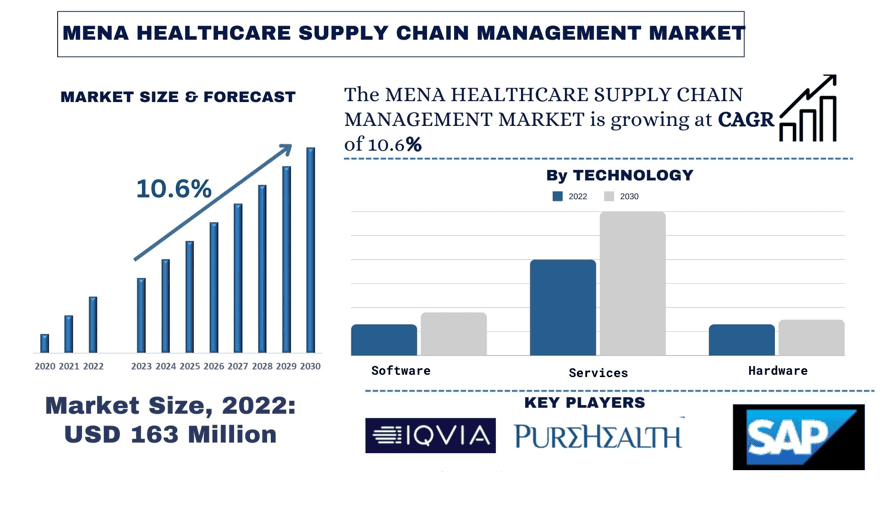
Wielkość i prognoza rynku zarządzania łańcuchem dostaw w sektorze opieki zdrowotnej w regionie MENA
Wartość rynku zarządzania łańcuchem dostaw w sektorze opieki zdrowotnej w regionie MENA wyniosła 163,83 mln USD w roku 2022 i oczekuje się, że w okresie prognozy będzie rósł w silnym tempie CAGR wynoszącym około 10,6%.
Analiza rynku zarządzania łańcuchem dostaw w sektorze opieki zdrowotnej w regionie MENA
Starzejące się społeczeństwo zwiększa zapotrzebowanie na usługi opieki zdrowotnej, co wymaga sprawnego zarządzania zaopatrzeniem medycznym. Ponadto inicjatywy rządowe mające na celu poprawę infrastruktury opieki zdrowotnej i dostępności napędzają wzrost rynku. Dodatkowo, rosnące inwestycje w cyfryzację i wdrażanie zaawansowanych technologii, takich jak blockchain i sztuczna inteligencja (AI), usprawniają logistykę i optymalizują zarządzanie zapasami, prowadząc do obniżenia kosztów i poprawy efektywności. Zgodnie z raportem Alpen Capital, w 2023 roku w ZEA ponad 50% szpitali korzysta z rozwiązań opartych na IoT, a 90% lekarzy używa smartfonów i aplikacji medycznych do świadczenia usług swoim pacjentom. W miarę jak region nadal traktuje priorytetowo modernizację opieki zdrowotnej, rynek zarządzania łańcuchem dostaw w sektorze opieki zdrowotnej w regionie MENA stoi na czele transformacyjnych innowacji, gotowy na trwały wzrost w nadchodzących latach.
Niektórzy z głównych graczy działają w SAP, Salehiya, IQVIA Inc, NUPCO, Purehealth, Global Medical Supply Chain, AcedrA Pharmaceutical Company LLC, Cardinal Health, Oracle, Tecsys Inc. Gracze ci podejmują liczne fuzje i przejęcia (M&As) wraz z partnerstwami, aby ułatwić klientom dostęp do zaawansowanych technologicznie i innowacyjnych sektorów/technologii.
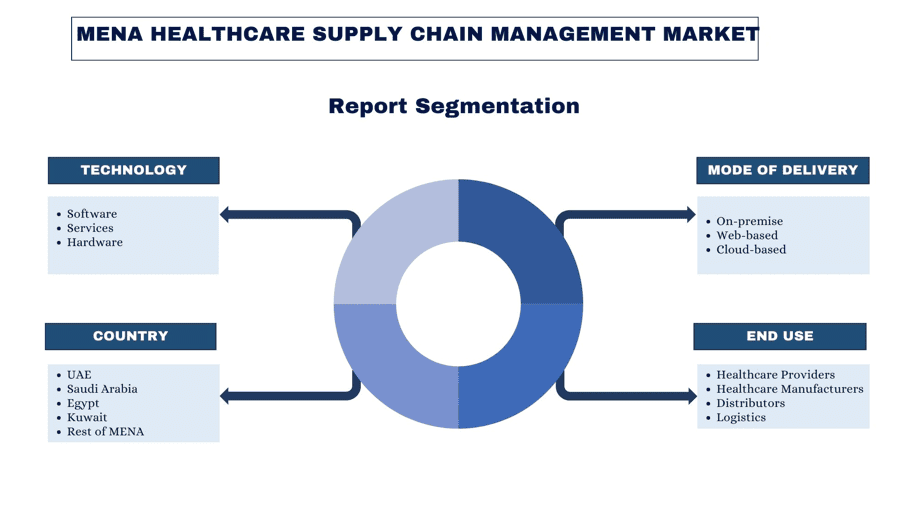 Trendy na rynku zarządzania łańcuchem dostaw w sektorze opieki zdrowotnej w regionie MENA
Trendy na rynku zarządzania łańcuchem dostaw w sektorze opieki zdrowotnej w regionie MENA
„Spośród technologii, oprogramowanie posiada dominujący udział w rynku w 2022 roku.”
W oparciu o technologię rynek jest podzielony na oprogramowanie, usługi i sprzęt. Wśród nich kategoria oprogramowania posiadała największy udział w rynku w 2022 roku. Zaawansowane systemy zarządzania zapasami śledzą poziomy zapasów w czasie rzeczywistym, zapobiegając brakom i nadmiernym zapasom, minimalizując w ten sposób straty i zapewniając efektywność kosztową. Ponadto, oprogramowanie do prognozowania popytu analizuje dane historyczne i trendy, aby przewidywać przyszłe potrzeby w zakresie zaopatrzenia medycznego, umożliwiając dostawcom opieki zdrowotnej składanie świadomych zamówień i zapobieganie zakłóceniom. Na przykład, 23 października 2023 roku Ministerstwo Finansów ZEA uruchomiło inicjatywy transformacji cyfrowej z wykorzystaniem rozwiązań metaverse i AI.
„Spośród użytkowników końcowych, oczekuje się, że dostawcy opieki zdrowotnej będą rosnąć ze znacznym CAGR w okresie prognozy (2023-2030).”
W oparciu o użytkownika końcowego, rynek jest podzielony na producentów opieki zdrowotnej, dostawców opieki zdrowotnej, dystrybutorów i logistykę. Oczekuje się, że dostawcy opieki zdrowotnej będą rosnąć ze znacznym CAGR w okresie prognozy ze względu na aktywne wdrażanie zaawansowanych rozwiązań programowych do zarządzania zapasami, prognozowania popytu i optymalizacji magazynów w celu usprawnienia operacji i obniżenia kosztów. Ci dostawcy, w tym szpitale, kliniki i inne placówki opieki zdrowotnej, w dużym stopniu polegają na dobrze zorganizowanym i responsywnym łańcuchu dostaw, aby utrzymać bezproblemowe działanie.
„Arabia Saudyjska przewodzi na rynku.”
Rynek zarządzania łańcuchem dostaw w sektorze opieki zdrowotnej w Arabii Saudyjskiej posiadał największy udział w rynku w 2022 roku. Program Wizja 2030 priorytetowo traktuje rozwój opieki zdrowotnej, co prowadzi do ogromnych inwestycji w infrastrukturę szpitalną, sprzęt medyczny i produkcję farmaceutyczną. Na przykład, w grudniu 2022 roku Kuwait-Saudi Pharmaceutical Industries Company (KSPICO) nawiązała współpracę z brytyjską firmą Rosemont Pharmaceuticals. Dzięki temu partnerstwu KSPICO będzie licencjonować i dystrybuować szereg produktów Rosemont w regionach GCC i MENA. Ten wzrost popytu wymaga wydajnych rozwiązań w zakresie zarządzania łańcuchem dostaw. Dodatkowo, nacisk rządu na lokalizację produkcji farmaceutycznej i promowanie samowystarczalności stwarza możliwości dla krajowych graczy w sektorze zarządzania łańcuchem dostaw. Ponadto, rosnące w saudyjskim systemie opieki zdrowotnej wdrażanie usług telezdrowotnych wymaga wydajnej logistyki w zakresie dostarczania leków i sprzętu medycznego do domów pacjentów.
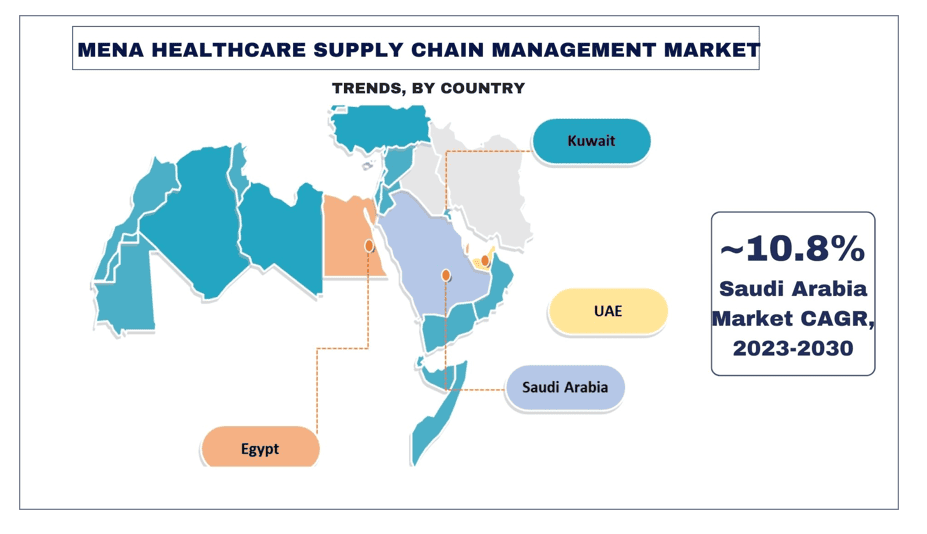
Zakres raportu dotyczącego rynku zarządzania łańcuchem dostaw w sektorze opieki zdrowotnej w regionie MENA
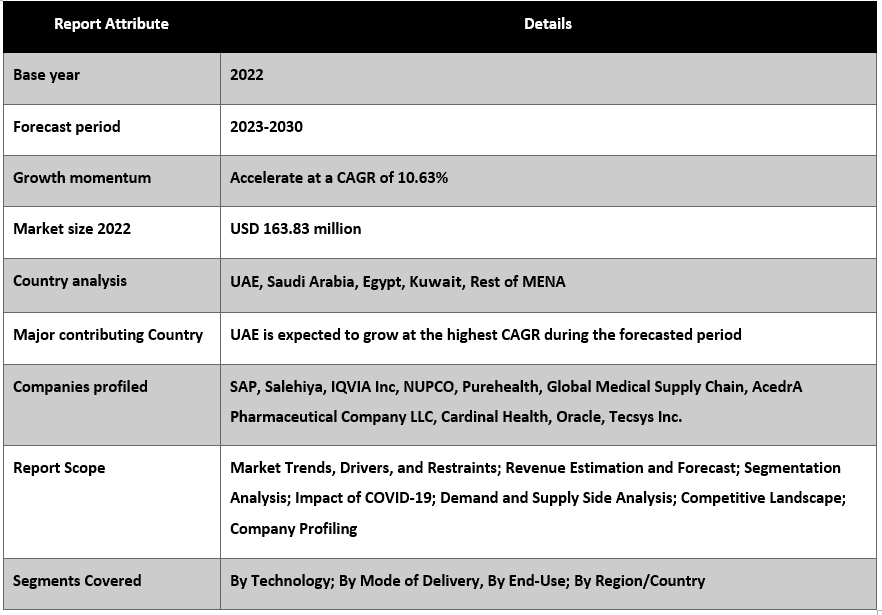
Powody, dla których warto kupić ten raport:
- Badanie obejmuje analizę wielkości rynku i prognozowania, zatwierdzoną przez uwierzytelnionych kluczowych ekspertów branżowych.
- Raport przedstawia szybki przegląd ogólnej wydajności branży na pierwszy rzut oka.
- Raport obejmuje dogłębną analizę wybitnych podmiotów z branży, z głównym naciskiem na kluczowe dane finansowe przedsiębiorstw, portfele sektorowe, strategie ekspansji i najnowsze wydarzenia.
- Szczegółowe badanie czynników napędzających, ograniczeń, kluczowych trendów i możliwości występujących w branży.
- Badanie kompleksowo obejmuje rynek w różnych segmentach.
- Dogłębna analiza regionalna branży.
Opcje dostosowywania:
Rynek zarządzania łańcuchem dostaw w sektorze opieki zdrowotnej w regionie MENA można dodatkowo dostosować zgodnie z wymaganiami lub dowolnym innym segmentem rynku. Poza tym, UMI rozumie, że możesz mieć własne potrzeby biznesowe, dlatego skontaktuj się z nami, aby otrzymać raport, który w pełni odpowiada Twoim wymaganiom.
Spis treści
Metodologia badań dla analizy rynku zarządzania łańcuchem dostaw w sektorze opieki zdrowotnej w regionie MENA (2023-2030)
Analiza historycznego rynku, szacowanie obecnego rynku i prognozowanie przyszłego rynku zarządzania łańcuchem dostaw w sektorze opieki zdrowotnej w regionie MENA to trzy główne kroki podjęte w celu stworzenia i przeanalizowania adaptacji zarządzania łańcuchem dostaw w sektorze opieki zdrowotnej w regionie MENA w głównych krajach. Przeprowadzono wyczerpujące badania wtórne w celu zebrania danych historycznych dotyczących rynku i oszacowania obecnej wielkości rynku. Po drugie, aby zweryfikować te spostrzeżenia, wzięto pod uwagę liczne ustalenia i założenia. Ponadto przeprowadzono również wyczerpujące wywiady podstawowe z ekspertami branżowymi w całym łańcuchu wartości rynku zarządzania łańcuchem dostaw w sektorze opieki zdrowotnej w regionie MENA. Po założeniu i zatwierdzeniu danych rynkowych poprzez wywiady podstawowe, zastosowaliśmy podejście odgórne/oddolne w celu prognozowania całkowitej wielkości rynku. Następnie przyjęto metody podziału rynku i triangulacji danych w celu oszacowania i analizy wielkości rynku segmentów i podsegmentów danej branży. Szczegółowa metodologia została wyjaśniona poniżej:
Analiza historycznej wielkości rynku
Krok 1: Dogłębne badanie źródeł wtórnych:
Przeprowadzono szczegółowe badania wtórne w celu uzyskania danych historycznych dotyczących wielkości rynku zarządzania łańcuchem dostaw w sektorze opieki zdrowotnej w regionie MENA poprzez wewnętrzne źródła firm, takie jak raporty roczne i sprawozdania finansowe, prezentacje wyników, komunikaty prasowe itp. oraz źródła zewnętrzne, w tym czasopisma, wiadomości i artykuły, publikacje rządowe, publikacje konkurencji, raporty sektorowe, bazy danych stron trzecich i inne wiarygodne publikacje.
Krok 2: Segmentacja rynku:
Po uzyskaniu danych historycznych dotyczących wielkości rynku zarządzania łańcuchem dostaw w sektorze opieki zdrowotnej w regionie MENA przeprowadziliśmy szczegółową analizę wtórną w celu zebrania danych historycznych dotyczących rynku oraz udziału różnych segmentów i podsegmentów w głównych regionach. Główne segmenty uwzględnione w raporcie to technologia, sposób dostawy i końcowe zastosowanie. Przeprowadzono dalsze analizy na poziomie krajowym w celu oceny ogólnego przyjęcia modeli testowania w danym regionie.
Krok 3: Analiza czynnikowa:
Po uzyskaniu danych historycznych dotyczących wielkości rynku różnych segmentów i podsegmentów przeprowadziliśmy szczegółową analizę czynnikową w celu oszacowania obecnej wielkości rynku zarządzania łańcuchem dostaw w sektorze opieki zdrowotnej w regionie MENA. Ponadto przeprowadziliśmy analizę czynnikową z wykorzystaniem zmiennych zależnych i niezależnych, takich jak sektor, zastosowanie i materiał rynku zarządzania łańcuchem dostaw w sektorze opieki zdrowotnej w regionie MENA. Przeprowadzono dokładną analizę scenariuszy popytu i podaży, uwzględniając najważniejsze partnerstwa, fuzje i przejęcia, ekspansję działalności i uruchomienia sektorowe w sektorze zarządzania łańcuchem dostaw w sektorze opieki zdrowotnej w regionie MENA na całym świecie.
Szacunek bieżącej wielkości rynku i prognoza
Określenie bieżącej wielkości rynku: W oparciu o praktyczne spostrzeżenia z powyższych 3 kroków, doszliśmy do obecnej wielkości rynku, kluczowych graczy na rynku zarządzania łańcuchem dostaw w sektorze opieki zdrowotnej w regionie MENA oraz udziałów w rynku poszczególnych segmentów. Wszystkie wymagane udziały procentowe i podziały rynku zostały określone przy użyciu wspomnianego powyżej podejścia wtórnego i zostały zweryfikowane poprzez wywiady podstawowe.
Szacowanie i prognozowanie: Do szacowania i prognozowania rynku przypisano wagi różnym czynnikom, w tym czynnikom napędowym i trendom, ograniczeniom i możliwościom dostępnym dla zainteresowanych stron. Po przeanalizowaniu tych czynników zastosowano odpowiednie techniki prognozowania, tj. podejście odgórne/oddolne, aby dojść do prognozy rynkowej na 2030 rok dla różnych segmentów i podsegmentów na głównych rynkach. Metodologia badań przyjęta do oszacowania wielkości rynku obejmuje:
- Wielkość rynku branży pod względem przychodów (USD) oraz stopień adopcji zarządzania łańcuchem dostaw w sektorze opieki zdrowotnej w regionie MENA na głównych rynkach krajowych
- Wszystkie udziały procentowe, podziały i rozbicia segmentów i podsegmentów rynku
- Kluczowi gracze na rynku zarządzania łańcuchem dostaw w sektorze opieki zdrowotnej w regionie MENA pod względem oferowanych sektorów. Ponadto strategie rozwoju przyjęte przez tych graczy, aby konkurować na szybko rozwijającym się rynku
Walidacja wielkości rynku i udziału w rynku
Badania podstawowe: Przeprowadzono dogłębne wywiady z kluczowymi liderami opinii (KOL), w tym z kadrą kierowniczą najwyższego szczebla (CXO/VP, szef sprzedaży, szef marketingu, szef operacyjny, szef regionalny, szef krajowy itp.) w głównych regionach. Następnie podsumowano wyniki badań podstawowych i przeprowadzono analizę statystyczną w celu udowodnienia postawionej hipotezy. Dane z badań podstawowych zostały połączone z wynikami badań wtórnych, przekształcając w ten sposób informacje w praktyczne spostrzeżenia.
Kluczowi interesariusze rynku zarządzania łańcuchem dostaw w sektorze opieki zdrowotnej w regionie MENA
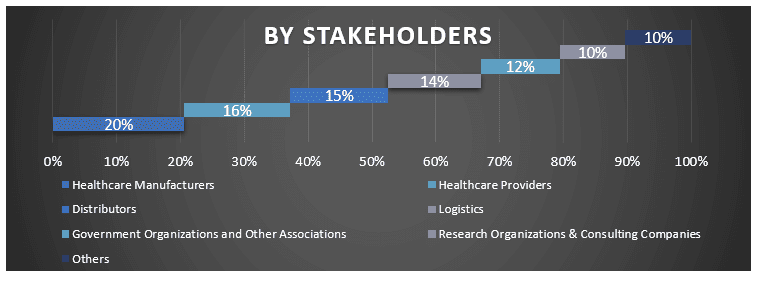
Inżynieria rynku
Zastosowano technikę triangulacji danych w celu ukończenia ogólnego szacowania rynku i uzyskania precyzyjnych danych statystycznych dla każdego segmentu i podsegmentu rynku zarządzania łańcuchem dostaw w sektorze opieki zdrowotnej w regionie MENA. Dane zostały podzielone na kilka segmentów i podsegmentów po przestudiowaniu różnych parametrów i trendów w obszarach technologii, sposobu dostawy i końcowego zastosowania rynku zarządzania łańcuchem dostaw w sektorze opieki zdrowotnej w regionie MENA.
Główny cel badania rynku zarządzania łańcuchem dostaw w sektorze opieki zdrowotnej w regionie MENA
W badaniu wskazano obecne i przyszłe trendy rynkowe rynku zarządzania łańcuchem dostaw w sektorze opieki zdrowotnej w regionie MENA. Inwestorzy mogą uzyskać strategiczne spostrzeżenia, na których mogą oprzeć swoje decyzje inwestycyjne, na podstawie analizy jakościowej i ilościowej przeprowadzonej w badaniu. Obecne i przyszłe trendy rynkowe określiły ogólną atrakcyjność rynku na poziomie regionalnym i krajowym, zapewniając uczestnikom przemysłowym platformę do wykorzystania niewykorzystanego rynku, aby skorzystać z przewagi pioniera. Inne cele ilościowe badań obejmują:
- Analizę obecnej i prognozowanej wielkości rynku zarządzania łańcuchem dostaw w sektorze opieki zdrowotnej w regionie MENA pod względem wartości (USD). Ponadto analizę obecnej i prognozowanej wielkości rynku różnych segmentów i podsegmentów
- Segmenty w badaniu obejmują obszary technologii, sposobu dostawy i końcowego zastosowania
- Definiowanie i analiza ram regulacyjnych dla branży zarządzania łańcuchem dostaw w sektorze opieki zdrowotnej w regionie MENA
- Analizę łańcucha wartości związanego z obecnością różnych pośredników, wraz z analizą zachowań klientów i konkurentów w branży
- Analizę obecnej i prognozowanej wielkości rynku zarządzania łańcuchem dostaw w sektorze opieki zdrowotnej w regionie MENA dla głównego regionu
- Główne kraje regionów badanych w raporcie to Arabia Saudyjska, ZEA, Egipt, Kuwejt i pozostała część regionu MENA
- Profile firm działających na rynku zarządzania łańcuchem dostaw w sektorze opieki zdrowotnej w regionie MENA oraz strategie rozwoju przyjęte przez uczestników rynku w celu utrzymania się na szybko rozwijającym się rynku
- Dogłębna analiza branży na poziomie regionalnym
Najczęściej zadawane pytania FAQ
P1: Jaka jest obecna wielkość rynku i potencjał wzrostu rynku zarządzania łańcuchem dostaw w sektorze opieki zdrowotnej w regionie MENA?
P2: Jakie są czynniki napędzające wzrost rynku zarządzania łańcuchem dostaw w sektorze opieki zdrowotnej w regionie MENA?
P3: Który segment ma największy udział w rynku Zarządzania Łańcuchem Dostaw Opieki Zdrowotnej MENA pod względem technologii?
P5: Który kraj zdominuje rynek zarządzania łańcuchem dostaw w sektorze opieki zdrowotnej w regionie MENA?
P6: Kim są kluczowi gracze działający na rynku zarządzania łańcuchem dostaw w sektorze opieki zdrowotnej w regionie MENA?
Powiązane Raporty
Klienci, którzy kupili ten przedmiot, kupili również










